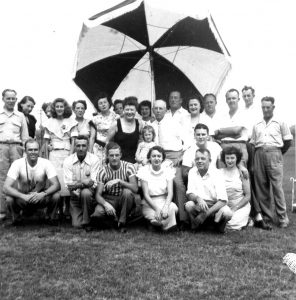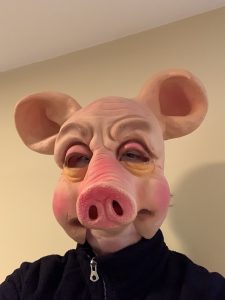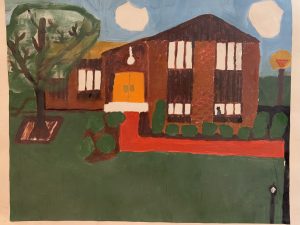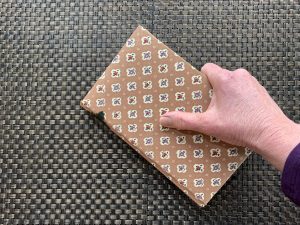How the World Has and Hasn’t Changed Since My Family’s Reunion Started Almost 100 Years Ago
For the first time in 97 years, my family did not gather in Central Illinois this past August for the Gray Reunion. It just didn’t seem safe to bring 25 people together in Weldon Park during a pandemic to socialize and share food.
As the Secretary-Treasurer of The Gray, it was my job to confirm the date and time with the President and send out the invites. So I started polling family members in early July.
“No way!” My cousin Nancy wrote in an email. “We have too many old people. I’m an old person. We don’t want to die!”
Nobody else I asked reacted quite like that, but there was no support for an in-person gathering. Yet it seemed to me that we shouldn’t let the reunion lapse, especially since we are so close to celebrating 100 straight years.
So we did a Zoom Gray Reunion instead, recording and posting it on YouTube afterwards.
I’m sure that my great-grandparents Emmett and Alice Gray, who founded the reunion in 1923, would never have dreamed of such a thing.
And yet there are so many parallels to their world back then and ours today. The old French proverb, “the more things change, the more they stay the same,” is really true in this case. These three things were just as life-changing back then as they are today.
1. Health Crisis
The Gray Reunion was founded only three years after the Spanish Flu pandemic had ended in 1920. About 675,000 people in the U.S. had lost their lives during its two-year course, with 25,000 deaths in Illinois. Right now, approximately 397,000 in the U.S. and 22,000 in Illinois have died from Covid-19 in the past year.
During the Spanish Flu pandemic, schools, theaters, and places of worship were closed. Public transportation was limited and mass gatherings banned. In September 1918, the Red Cross recommended wearing face masks, but like today, many resisted this. The most vocal was a group called the Anti-Mask League of San Francisco whose members questioned the scientific data and felt that their civil liberties were being violated.
Similar to now, some also felt back then that the U.S. government was lying about the severity of the flu pandemic because it didn’t want to disrupt the war effort in Europe.
2. Women’s Rights
Women were also finding their political voice when The Gray was founded, earning the right to vote in 1920. However it would be years until the number of eligible women voters would equal that of the men. In 2020, the American people elected Kamala Harris as the first woman to hold the office of vice president since elections began 242 years earlier. In contrast, it only took 30 years for the first woman to be elected assistant vice president of the Gray Reunion and 50 years for a woman to be elected president.
I’m sure it probably never occurred to Emmett and his sons in the early days of the reunion to elect a woman president. And the women of the Gray were not about to challenge their men. They had their hands full preparing the food for the reunion, getting everyone ready to go, and keeping an eye on the children once they were there. Little did those men know that their women could have done all that and also run the business meeting too.
3. Democracy in Action
Like our country, The Gray is governed in a democratic fashion with elected officers. Those officers are in charge of organizing the reunion and running a meeting to discuss the business of the reunion – like where next year’s reunion will be held, electing officers, and forming committees to do tasks. People nowadays typically serve one- or two-year terms as president and secretary-treasurer.
In the past, reunion members also elected vice presidents and assistant vice presidents, which I assume was done to make people feel important and included. Today, very few Gray family descendants want to the job, so it’s always the same three or four people who agree to serve and get elected.
Unlike the U.S. presidency, there are no term limits. But rarely has anyone served more than two consecutive terms. There’s always a peaceful transfer of power with a welcoming nod to the incoming president and the box that contains all the minutes and records passed along to the new secretary-treasurer.
The number of people attending the reunion has dwindled in recent years. And none of Emmett and Alice’s five children or their spouses are still alive. But they would be proud that we have kept the reunion going – even during a pandemic. Because family traditions matter.
Editor’s Note
This post first appeared in Sara Marberry’s blog, The View from Here.
Obituary for Harriet O’Daffer: Loving Wife of 66 Years to Phares O’Daffer
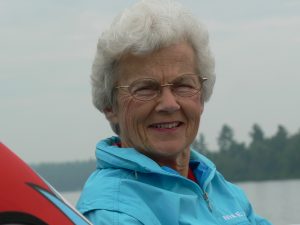 Harriet Gove O’Daffer passed away September 27 at Carle Bro-Menn Medical Center in Normal, Illinois, after a 13 year struggle with Alzheimer’s Disease. She was 87 years old.
Harriet Gove O’Daffer passed away September 27 at Carle Bro-Menn Medical Center in Normal, Illinois, after a 13 year struggle with Alzheimer’s Disease. She was 87 years old.
Harriet was born July 6, 1933 in Newton, Iowa to Sabin and Mildred Gove, who preceded her in death. She is survived by her husband of 66 years, Phares O’Daffer, as well as her sister Ellen (Robert) Greeley of Eureka, Ill. and brother Jack (Jean) Gove of East Peoria, Ill.
Also surviving are Harriet’s beloved children, daughters Sue (Bruce) Thornquist of Downers Grove, Ill.; Sara (Richard) Marberry of Evanston, Ill; and son Eric (Stacy) O’Daffer of Sammamish, Wa. Harriet deeply loved her grandchildren, Jordan Thornquist, Dana Thornquist, Lee Thornquist, and Wesley Marberry (Chicago); Alison O’Daffer (Seattle); and Will O’Daffer and Henry O’Daffer (Sammamish, Wa). They also survive her.
Honored as a McLean County Woman of Distinction in 1996, Harriet was a solid person who could always be counted on. She was admired and respected by her family, friends, and colleagues in her church and community.
Harriet loved her community, and was known for her volunteer work and leadership at Normal First United Methodist Church, Unit 5 School Board, Illinois Symphony Board, Illinois Shakespeare Society Board, and the Board of her beloved Baby Fold. Other cherished organizations were P.E.O and the Normal History Club.
After graduating from Illinois State University (ISU), Harriet was an outstanding fourth grade teacher for two years at Franklin School in Bloomington.
Harriet loved music, and greatly enjoyed playing her piano and singing. She also loved theater, the symphony, a good book, watching sports, playing golf and tennis, hiking, playing bridge, and experiencing a great trip. She was also a huge fan of the Chicago Cubs and the ISU Redbirds.
All of her life Harriet showed her love, devotion, and support for her husband, her children, their spouses, her grandchildren, and her friends, and they loved her very much.
Want to Know More About Harriet?
Download a 24-page 80th Birthday Tribute to Harriet Gove O’Daffer written and published by Phares O’Daffer in 2013.
Looking For Clues
When I was a kid, we used to go tromping through cemeteries.
My dad, as you’ve probably figured out, is Phares O’Daffer, the “stumbleologist” who has spent a lot of his spare time in the last 58 years collecting and sharing information on our ancestors.
On family vacations or trips out east, we’d often take detours through the countryside to find old gravesites. Particularly in Ohio or Pennsylvania where some of the earliest Odaffers lived.
“Alright, everybody out of the car,” Dad would announce as he pulled our station wagon up to some tombstone grassy knoll. “Start looking for Odaffers.”
My sister Sue and I would pull our heads out of our books, put our shoes on, and gamely start tromping through the cemetery looking at each tombstone for clues to our past. It was a game for Eric, our brother, who was too little to know what we were doing. Mom went along with it because she knew how important it was to Dad.
And, like everything he does, Dad made it fun. “You’ve got 10 minutes,” he said. “Find me someone who was born in 1850. First one who does gets a milkshake.”
Come to think of it, running around a cemetery was a brilliant ploy to break up the monotony of riding in the car on a long trip. Get some exercise and tire us out so we’d stop asking, “Are we there yet?” And no matter who found what, we all got milkshakes.
Also, it was a way for Dad to involve all of us in his research into our family history. I never really appreciated that as a kid. As we grew older, none of us became interested enough in genealogy to carry on where he left off.
But I don’t think Dad ever expected that. He just wanted to pursue his passion and be able to share what he’d learned. Hence, this website.
Turns out that Dad’s first big discovery about our ancestors didn’t happen in a cemetery, but a library. The Daughters of the American Revolution Genealogy Library in Washington, D.C., to be exact.
Searching for clues in libraries on our family vacations wouldn’t have been nearly as much fun as going to cemeteries.


